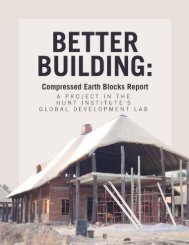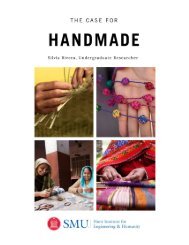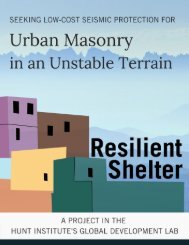Assessment of Rwanda Refugee Camps in the Context of the Villagization Process
Undergraduate researcher for the Hunt Institute for Engineering and Humanity and Engaged Learning Fellow Sienna Dugan, researched secondary sources and primary research through site visits, participatory observation, and interviews with key informants to compile this report which is structured like a case study with additional literature review. All photography is original to the student from her in-field research.
Undergraduate researcher for the Hunt Institute for Engineering and Humanity and Engaged Learning Fellow Sienna Dugan, researched secondary sources and primary research through site visits, participatory observation, and interviews with key informants to compile this report which is structured like a case study with additional literature review. All photography is original to the student from her in-field research.
You also want an ePaper? Increase the reach of your titles
YUMPU automatically turns print PDFs into web optimized ePapers that Google loves.
sought to escape in the first place. Often located in rural areas with little to no access to commerce
centers, the lack of monetary generating activities around camps exacerbates the ability for
refugees to leave the camps once they have arrived. As refugees and displaced people enter this
state of protraction, emergency assistance moves to focus on protection and assistance.
Implementation of CRRF show that a shift has begun to occur from the traditional top down
approach of the distribution of supplies and resources to a more community-based, inclusive
approach. Although this transition to cash-based assistance, integration of refugees into local
schools, and the development of shared water filtration systems provides refugees increased
opportunity for autonomy, the current layout of Mahama creates barriers on the path to selfreliance.
In order to make the transition from a refugee camp to a refugee city in Mahama,
solutions to high camp density, distance from other commerce centers/markets, lack of available
employment opportunities, and lack of agricultural land available to refugees must be further
explored and implemented. Taking lessons learned from villagization processes implemented in
Ethiopia and Tanzania, access to community centers and places of commerce are essential to
enhancing refugee self-reliance and eventually the creation of a self-sustaining village.
Although the current global refugee situation has been framed in mass media as a fight for
those displaced to find new homes in countries, often via unofficial routes, falling foul to strict
boarder control policies, mass amounts of data suggest that if implemented correctly refugee
integration can be extremely beneficial to hosting countries.21 Various studies show that the
acceptance of refugees does not deteriorate host countries economic performance or fiscal balances
but in results in positive macroeconomic impacts with refugee nationalization.22 Another study
21 Loschmann, C., Bilgili, Ö. & Siegel, M. Considering the benefits of hosting refugees: evidence of refugee camps influencing local labour
market activity and economic welfare in Rwanda. IZA J Develop Migration 9, 5 (2019) doi:10.1186/s40176-018-0138-2
22 d’Albis, H., Boubtane, E. & Coulibaly, D. Sci. Adv. 4, eaaq0883 (2018)
29














